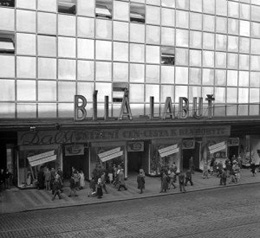
<div>Bílá labuť má 80 let, svého času byla nejmodernější v ČR</div><div>The White Swan is 80 years old, it was the most modern in the Czech Republic at its time.</div>
 |
At its opening in 1939, this building by architects Josef Kittrich and Josef Hrubý attracted attention as it was equipped with several then-unprecedented amenities in Bohemia: for example, escalators, ceiling heating, or air conditioning. It even boasted European unique features - a cashier's pneumatic tube system and automated (slip) waste collection. The advertising lighting, dominated by an eight-meter rotating neon swan, was also unusual.
Remarkable at the time were also the capacity and speed of the elevators and escalators (up to 4000 people per hour). A total of five large passenger elevators for 10 people, a freight elevator, and a moving staircase from the ground floor to the first floor were installed (the first in Prague placed indoors - the first escalator in Czechoslovakia is often cited as the wooden moving stairs on the route of the discontinued cableway to Letná, which operated from 1926 to 1935).
The building had a total of 11 floors, two of which were underground. Above the sixth administrative floor was a three-story tower structure with a terrace, which was then accessible to the public. Three floors below was a smaller terrace for employees, where they could spend their lunch break on loungers under umbrellas. Each floor had rest areas for customers, caretakers in the children's play area took care of small children, and there was also a luggage and pram storage available.
The main facade of Bílá labuť up to five floors was essentially one gigantic window measuring 30 x 18 meters, made of 180 panes of opaque silver-gray glass providing thermal and sound insulation. The interior design was then created by academic architect Jan Gillar.
Bílá labuť was built on the site of a single-story house with an inn located by a once-busy trading route. The house had a famous cabaret, which moved to Ostrovní Street in the 1880s, but the famous cabaret U Labutě remained there until 1937. Since 1910, there was also a cinema for the Invalids in the building. In the 1930s, the well-known Prague entrepreneur Jaroslav Brouk bought the house to build a modern "store". In the summer of 1937, he demolished the old building and constructed a glass palace in its place within 25 months.
Since then, the department store has undergone several partial renovations. It served its purpose even during the former regime. However, in recent years, these classic shopping centers have been struggling with new modern centers built mostly on the outskirts of large cities, which offer customers greater comfort and broader services.
The oldest modern department store in Prague (Haas's House) was built on Na Příkopech between 1869 and 1871 in the neo-Renaissance style according to a design by architect Aleš Linsbauer. Behind the representative facade with Corinthian columns, designed by Viennese architect Theofil Hansen, was a system of cast-iron structures.
The English translation is powered by AI tool. Switch to Czech to view the original text source.
0 comments
add comment












